Periya Puranam
Historical background
Tamil legendary poetic narrative of the life of the 63 Shaiva saints (nayanmars) compiled in the 12th century by Sekkilar.

Date: Paintings: late 19th, early 20th century
Description: (Left): Celebrations at theTyagarajaTemple,Tiruvarur; (Right): The story of Amarniti Adigal nayanmar.
Location: Tamil Nadu Temple;Atmanatha Temple;Avudaiyarkoyil
Positioning: Sivananda Manikkavachakar shrine, prakara east wall

Date: Paintings: late 19th, early 20th century
Description: From left to right: The stories of Eripatta nayanmar; Yenati nayanmar and Kannappa nayanmar.
Location: Tamil Nadu Temple;Atmanatha Temple;Avudaiyarkoyil
Positioning: Sivananda Manikkavachakar shrine, prakara east wall

Date: Paintings: late 19th, early 20th century
Description: From left to right: The stories of Kunkuliya Kalaya nayanmar and of Manakkancharar nayanmar.
Location: Tamil Nadu Temple;Atmanatha Temple;Avudaiyarkoyil
Positioning: Sivananda Manikkavachakar shrine, prakara, south east corner

Date: Paintings: late 19th, early 20th century
Description: The story of Kunkuliya Kalaya nayanmar.
Location: Tamil Nadu Temple;Atmanatha Temple;Avudaiyarkoyil
Positioning: Sivananda Manikkavachakar shrine, prakara, south east corner

Date: Paintings: late 19th, early 20th century
Description: From left: The story of Manakkancharar nayanmar and the story of Arivattaya nayanmar.
Location: Tamil Nadu Temple;Atmanatha Temple;Avudaiyarkoyil
Positioning: Sivananda Manikkavachakar shrine, prakara, south wall

Date: Paintings: late 19th, early 20th century
Description: From left: The story of Anaya nayanmar and the story of Murti nayanmar.
Location: Tamil Nadu Temple;Atmanatha Temple;Avudaiyarkoyil
Positioning: Sivananda Manikkavachakar shrine, prakara, south wall

Date: Paintings: late 19th, early 20th century
Description: From left; The story of Murti nayanmar and the story of Muruga nayanmar.
Location: Tamil Nadu Temple;Atmanatha Temple;Avudaiyarkoyil
Positioning: Sivananda Manikkavachakar shrine, prakara, south wall

Date: Paintings: late 19th, early 20th century
Description: From left: The story of Manakkancharar nayanmar the story of Arivattaya nayanmar and the story of Anaya nayanmar.
Location: Tamil Nadu Temple;Atmanatha Temple;Avudaiyarkoyil
Positioning: Sivananda Manikkavachakar shrine, prakara,south wall

Date: Paintings: late 19th, early 20th century
Description: From left: The story of Murti nayanmar and the story of Muruga nayanmar.
Location: Tamil Nadu Temple;Atmanatha Temple;Avudaiyarkoyil
Positioning: Sivananda Manikkavachakar shrine, prakara, south wall

Date: Paintings: late 19th, early 20th century
Description: From left: The story of Rudra Pashupati nayanmar;
The story of Tirunalaippovar nayanmar; The story of
Tirukkuripputtondar nayanmar.
Location: Tamil Nadu Temple;Atmanatha Temple;Avudaiyarkoyil
Positioning: Sivananda Manikkavachakar shrine, prakara, south wall

Date: Paintings: late 19th, early 20th century
Description: From left; The story of Chandesha nayanmar; Appar nayanmar flanked by two devotees.
Location: Tamil Nadu Temple;Atmanatha Temple;Avudaiyarkoyil
Positioning: Sivanada Manikkavachakar shrine, prakara, south wall

Date: Paintings: late 19th, early 20th century
Description: From left: Appar nayanmar with his hoe uproots the weeds in the Shaiva temples; The story of Kulachirayar (a minister-devotee); The story of Kurumba nayanmar (a tribal devotee).
Location: Tamil Nadu Temple;Atmanatha Temple;Avudaiyarkoyil
Positioning: Sivananda Manikkavachakar shrine, prakara, south wall

Date: Paintings: late 19th, early 20th century
Description: From left; The story of Kurumba nayanmar; The story of Karaikkal Ammaiyar.
Location: Tamil Nadu Temple;Atmanatha Temple;Avudaiyarkoyil
Positioning: Sivananda Manikkavachakar shrine, prakara, south wall

Date: Paintings: late 19th, early 20th century
Description: From left; The story of Appudi-Adigal nayanmar (a devotee of Appar); The story of Tirunilanakkar.
Location: Tamil Nadu Temple;Atmanatha Temple;Avudaiyarkoyil
Positioning: Sivanada Manikkavachakar shrine, prakara, south wall

Date: Paintings: late 19th, early 20th century
Description: The story of Naminandi Adigal nayanmar.
Location: Tamil Nadu Temple;Atmanatha Temple;Avudaiyarkoyil
Positioning: Sivananda Manikkavachakar shrine, prakara, south wall

Date: Paintings: late 19th, early 20th century
Description: The story of Sambandar. On the left: Shiva and Parvati arrive to console the hungry toddler crying while his father was having a bath in the temple tank. The goddess feeds him divine milk. His father threatens him with a cane. The child bursts into song in praise of Shiva. On the right: The child travels through South India singing the praise of Shiva.
Location: Tamil Nadu Temple;Atmanatha Temple;Avudaiyarkoyil
Positioning: Sivananda Manikkavachakar shrine, prakara, south west corner

Date: Paintings: late 19th, early 20th century
Description: The story of Sambandar. Vignettes illustrating various events of his life.
Location: Tamil Nadu Temple;Atmanatha Temple;Avudaiyarkoyil
Positioning: Sivananda Manikkavachakar shrine, prakara, west wall

Date: Paintings: late 19th, early 20th century
Description: The life of Sambandar. Vignettes illustrating the life of the saint.
Location: Tamil Nadu Temple;Atmanatha Temple;Avudaiyarkoyil
Positioning: Sivananda Manikkavachakar shrine, prakara, west wall

Date: Paintings: late 19th, early 20th century
Description: The life of Sambandar. Vignettes illustrating the life of the saint: His meeting with Appar and their pilgrimages through South India; Sambandar’s arrival in Madurai, where a magic fire engulfs his ashram.
Location: Tamil Nadu Temple;Atmanatha Temple;Avudaiyarkoyil
Positioning: Sivananda Manikkavachakar shrine, prakara, west wall

Date: Paintings: late 19th, early 20th century
Description: The life of Sambandar. Vignettes illustrating the life of the saint; The illness of Kun Pandya; The contests with the Jains and their subsequent impalement.
Location: Tamil Nadu Temple;Atmanatha Temple;Avudaiyarkoyil
Positioning: Sivananda Manikkavachakar shrine, prakara, west wall

Date: Paintings: late 19th, early 20th century
Description: The life of Sambandar. Vignettes illustrating the life of the saint.
Location: Tamil Nadu Temple;Atmanatha Temple;Avudaiyarkoyil
Positioning: Sivananda Manikkavachakar shrine, prakara, west wall

Date: Paintings: late 19th, early 20th century
Description: The life of Sambandar: The wedding of the saint and the merging of the whole party into Shiva.
Location: Tamil Nadu Temple;Atmanatha Temple;Avudaiyarkoyil
Positioning: Sivananda Manikkavachakar shrine, pradakshina patha, north wall

Date: Paintings: late 19th, early 20th century
Description: Top row: The life of Eyarkoan Kalikkama nayanmar.
Bottom row: Disappeared.
Location: Tamill Nadu Temple;Atmanatha Temple;Avudaiyarkoyil
Positioning: Sivananda Manikkavachakar shrine, prakara, north wall

Date: Paintings: late 19th, early 20th century
Description: Top row: The story of Dhandi Adigal nayanmar; the story of Somasimara nayanmar; Bottom row: The story of Murkha nayanmar (disappeared); The story of Sakkiya nayanmar.
Location: Tamil Nadu Temple;Atmanatha Temple;Avudaiyarkoyil
Positioning: Sivananda Manikkavachakar shrine, prakara,north wall

Date: Paintings: late 19th, early 20th century
Description: Top row: The story of Chirappuli nayanmar; The story of Cheraman Perumal nayanmar; Bottom row: The story of Siruttondar nayanmar; The story of Gananatha nayanmar
Location: Tamil Nadu Temple;Atmanatha Temple;Avudaiyarkoyil
Positioning: Sivananda Manikkavachakar shrine, prakara, north wall

Date: Paintings: late 19th, early 20th century
Description: Top row: The story of Kutruva nayanmar; Bottom row: The story of Poyyadimai Illadha Pulavar; On the right: Umamaheshvara flanked by Vighneshvara and Subrahmanya with consorts.
Location: Tamil Nadu Temple;Atmanatha Temple;Avudaiyarkoyil
Positioning: Sivananda Manikkavachakar shrine, prakara, north wall

Date: Paintings: late 19th, early 20th century
Description: On the left: Cholanadu, the Chola county; on the right; Tiruvarur, the story of Manuniti Cholan nayanmar.
Location: Tamil Nadu Temple;Atmanatha Temple;Avudaiyarkoyil
Positioning: Sivananda Manikkavackakar shrine, prakara, north wall

Date: Paintings: late 19th, early 20th century
Description: Scenes from the life of Sundarar nayanmar.
Location: Tamil Nadu Temple;Atmanatha Temple;Avudaiyarkoyil
Positioning: Sivananda Manikkavachakar shrine, prakara, north wall

Date: Paintings: late 19th, early 20th century
Description: Scenes from the life of Sundarar nayanmar.
Location: Tamil Nadu Temple;Atmanatha Temple;Avudaiyarkoyil
Positioning: Sivananda Manikkavachakar shrine; prakara, north wall

Date: Paintings: late 19th, early 20th century
Description: Scenes from the life of Sundarar nayanmar.
Location: Tamil Nadu Temple;Atmanatha Temple;Avudaiyarkoyil
Positioning: Sivananda Manikkavachakar shrine; prakara, north wall

Date: Paintings: late 19th, early 20th century
Description: Scenes from the life of Sundarar nayanmar.
Location: Tamil Nadu Temple;Atmanatha Temple;Avudaiyarkoyil
Positioning: Sivananda Manikkavachakar shrine, prakara, north east corner

Date: Paintings: late 19th, early 20th century
Description: Scenes from the life of Sundarar nayanmar.
Location: Tamil Nadu Temple;Atmanatha Temple;Avudaiyarkoyil
Positioning: Sivananda Manikkavachakar shrine, prakara, east wall

Date: Paintings: late 19th, early 20th century
Description: Scenes from the life of Sundarar nayanmar. Top left: Sundarar interrupts the flow of the Kaveri so that he and Cheraman Perumal can visit some temples on the other side of the river.
Location: Tamil Nadu Temple;Atmanatha Temple;Avudaiyarkoyil
Positioning: Sivananda Manikkavachakar shrine, prakara, east wall

Date: Paintings: late 19th, early 20th century
Description: Scenes from the life of Sundarar nayanmar; Top right Sundarar rescues a child from the jaws of a crocodile in Avinashi; Bottom left: the gods and an elephant sent by Shiva come to fetch Sundarar.
Location: Tamil Nadu Temple;AtmanathaTemple;Avudaiyarkoyil
Positioning: Sivananda Manikkavachakar shrine, prakara, east wall

Date: Paintings: late 19th, early 20th century
Description: Scenes from the life of Sundarar; Top left: Sundarar rescues a child from the jaws of a crocodlile in Avinashi; Bottom left: A divine elephant and the gods come to fetch Sundarar; On the right: Sundarar on the elephant and Cheraman Perumal on his horse ascend to Kailasa.
Location: Tamil Nadu Temple;Atmanatha Temple;Avudaiyarkoyil
Positioning: Sivananda Manikkavachakar shrine, prakara, east wall

Date: 18th-19th century
Description: The story of Sambandar. Top, worship scene; the Pandya queen invites the saint to Madurai; the Jains and the king; they send Agni to burn the house where the saint is living.
Location: Tamil Nadu Temple;Atmanatha Temple;Avudaiyarkoyil
Positioning: Panchatchara mandapa, ceiling of the east bay

Date: 18th-19th century
Description: Top; The king is ill and the Jains try to cure him; The queen talks to the king and goes to Sambandar; Centre: Sambandar is taken to Madurai, he heals the king; The books of the Jains are thrown in the fire and burn; Bottom: The books of the Jains are thrown in the river and they follow the current; A messenger is sent to Sambandar.
Location: Tamil Nadu Temple;Atmanatha Temple;Avudaiyarkoyil
Positioning: Panchatchara mandapa, ceiling of the east bay

Date: 18th-19th century
Description: Top: The books of the Jains are thrown in the river and they follow the curent; A messenger is sent to Sambandar; Bottom: The impalement of the Jains and Sambandar’s triumph.
Location: Tamil Nadu Temple;Atmanatha Temple;Avudaiyarkoyil
Positioning: Panchatchara mandapa, ceiling of the east bay
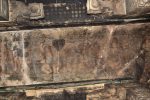
Date: First half of the 16th century
Description: From left to right: Kannappa worships the linga; the linga’s eyes bleed; Kannappa gouges first one of his eyes to replace the linga’s bleeding one; then the second eye of the linga starts bleeding. He prepares to give the linga his other eye. However, before doing so, he places his foot on the spot where his eye should be placed. In the moment Kannappa is on the verge of gouging his eye, when the hand of Shiva emerges from the linga, preventing him from doing so. Then, Shiva and Parvati appear and restore Kannappa’s sight.
Location: Andhra Pradesh Temple;Virabhadraswamy Temple;Lepakshi
Positioning: Mahamandapa, third bay from the east
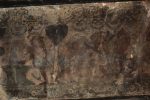
Date: First half of the 16th century
Description: From left to right: Kannappa worships the linga; the linga’s eyes bleed; Kannappa gouges first one of his eyes to replace the linga’s bleeding one; Then the second eye of the linga starts bleeding. He prepares to give the linga his other eye. However, before doing so, he places his foot on the spot where his eye should be placed. Kannappa is on the verge of gouging his eye when the hand of Shiva emerges from the linga, preventing him from doing so.
Location: Andhra Pradesh Temple;Virabhadraswamy Temple;lepakshi
Positioning: Mahamandapa, third bay from the east
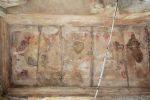
Date: First half of the 16th century
Description: King Manuniti Cholan, on a throne, accompanied by his attendants, faces three (?) seated figures, now damaged. On the left, a standing figure.
Location: Andhra Pradesh Temple;Virabhadraswamy Temple;Lepakshi
Positioning: Natyamandapa, north bay
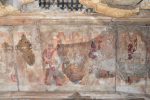
Date: First half of the 16th century
Description: The gate of a palace. Near it, barely visible, are the fragments of a figure, possibly a guard. Just outside the gateway a group of four, barely recognisable, gesticulating men bearing bows, perhaps the bodyguard of the prince, gather around a chariot that has just run over a calf. Its body is clearly visible right under the central wheel of the conveyance, towards which a large cow rushes. The prince and his attendant stand on the chariot and are engaged in an animated discussion with a dignified figure who standing behind the cow, appears to support the demands of the animal.
Location: Andhra Pradesh Temple;Virabhadraswamy Temple;Lepakshi
Positioning: Natyamandapa, north bay
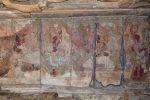
Date: First half of the 16th century
Description: Manuniti Cholan and a group of dignitaries inside a hall listen to the discourses of two sages. On the extreme left, the cow runs towards its dead calf.
Location: Andhra Pradesh Temple;Virabhadraswamy Temple;Lepakshi
Positioning: Natyamandapa, north bay
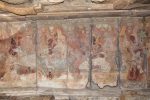
Date: First half of the 16th century
Description: Manuniti Cholan and a group of dignitaries inside a hall listen to the discourses of two sages. On the extreme left, the cow runs towards its dead calf.
Location: Andhra Pradesh Temple;Virabhadraswamy Temple;Lepakshi
Positioning: Natyamandapa, north bay
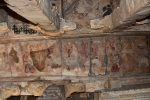
Date: First half of the 16th century
Description: The gate of a palace, capped by a two-storeyed tower. Near it are the fragments of a figure, possibly a guard. Just outside the gateway a group of four, barely recognisable, gesticulating men bearing bows, perhaps the bodyguard of the prince, gather around a chariot that has just run over a calf. Its body is clearly visible right under the central wheel of the conveyance, towards which a large the cow rushes. The prince and his attendant stand on the chariot and are engaged in an animated discussion with a dignified crowned figure who standing behind the cow, appears to support its cause. Manuniti and a group of dignitaries inside a hall listen to the discourses of two sages.
The cow walks towards the palace gateway, and by ringing the bell outside the hall she attracts the attention of a gate keeper and demands justice. Floating on a cloud above the cow’s head are two gandharvas
Location: Andhra Pradesh Temple;Virabhadraswamy Temple;Lepakshi
Positioning: Natyamandapa, north bay
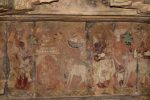
Date: First half of the 16th century
Description: The cow walks towards the palace gateway, and by ringing the bell outside the hall she attracts the attention of a gate keeper and demands justice. Floating on a cloud above the cow’s head are two gandharvas. On the right, Manuniti, his minister, the cow and yet another dignitary discuss the incident. Near the king is the diminutive prince.
Location: Andhra Pradesh Temple;Virabhadraswamy Temple;Lepakshi
Positioning: Natyamandapa, north bay
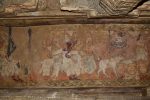
Date: First half of the 16th century
Description: A group of courtly figures seem to be discussing the case. Manuniti orders the prince to be punished; Along with two dignitaries he looks on while the chariot carrying the dead calf, followed by the anguished cow licking it, is driven over the prince. A shower of flowers falls from the sky.
Location: Andhra Pradesh Temple;Virabhadraswamy Temple;Lepakshi
Positioning: Natyamandpa, north bay
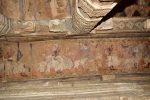
Date: First half of the 16th century
Description: King Manuniti and his ministers discuss the incident; the king decides to punish the prince and along with two dignitaries he looks on while the chariot carrying the dead calf, followed by the cow licking it, is driven over the prince. A shower of flowers falls from the sky. On the extreme right; Shiva and Parvati appear riding on Nandi accompanied by a host of ganas and restore to life the prince and the calf.
Location: Andhra Pradesh Temple;Virabhadraswamy Temple;Lepakshi
Positioning: Natyamandapa, north bay
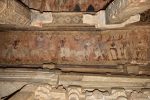
Date: First half of the 16th century
Description: Manuniti decides to punish the prince and along with two dignitaries he looks on while the chariot carrying the dead calf, followed by the cow licking it, is driven over the prince. A shower of flowers falls from the sky. On the extreme right; Shiva and Parvati appear riding on Nandi accompanied by a host of ganas and restore to life the prince and the calf.
Beginning of an unidentified narrative. From the remaining fragments it is possible to recognise a four-armed deity, probably Shiva, surrounded by a group of women.
Location: Andhra Pradesh Temple;Virabhadraswamy Temple;Lepakshi
Positioning: Natyamandapa, north bay
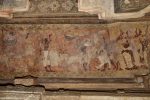
Date: First half of the 16th century
Description: The chariot carrying the dead calf crushes the prince to death. Shiva and Parvati riding on Nandi appear followed by a host of ganas and resuscitate the prince and the calf. A rain of flowers falls from the sky on the group. On the extreme right fragments of an unidentified narrative: a four-armed deity, probably Shiva, surrounded by a group of women.
Location: Andhra Pradesh Temple;Virabhadraswamy Temple;Lepakshi
Positioning: Natyamandapa, north bay
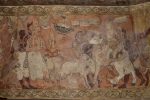
Date: First half of the 16th century
Description: Before the eyes of Manuniti and his minister, Shiva and Parvati riding on Nandi, accompanied by a host of ganas appear on the scene and restore the prince and the calf to life. A gandharvi floating on a cloud strews flower petals on the group.
Location: Andhra Pradesh Temple;Virabhadraswamy Temple;Lepakshi
Positioning: Natyamandapa, north bay
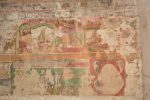
Date: 17th century
Description: Top row: A king, probably Manuniti Cholan, listens to a brahmin; Some dignitaries visit him; Bottom row(right): The anthill where Valmikinatha (Shiva) resides. The next scenes, almost disappeared, are part of the Manuniti Cholan narrative.
Location: Tamil Nadu Temple;Tyagaraja temple;Tiruvarur
Positioning: Devasiriya mandapa, north wall
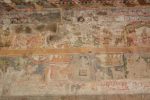
Date: 17th century
Description: Top row: A royal figure riding a chariot preceded by a dancer and followed by a camel rider beating a kettle drum and a horseman. Bottom row: Conclusion of the story of king Manuniti Cholan: Shiva and Parvati on Nandi are worshipped by the gods and devotees.
Location: Tamil Nadu Temple;Tyagaraja Temple;Tiruvarur
Positioning: Devasiriya mandapa, north wall
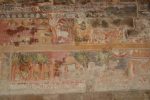
Date: 17th century
Description: Top row: The royal army on parade. A cow and a calf frisk before the Tyagaraja temple. Bottom row: Manuniti Cholan orders his son to be run over by the chriot which killed the calf.
Location: Tamil NaduTemple;Tyagaraja Temple;Tiruvarur
Positioning: Devasiriya mandapa, north wall
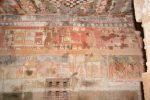
Date: 17th century
Description: Top row: View of the Tyagaraja Temple with the sanctuaries of Tyagaraja and Valmikinatha. Bottom row: The cow arrives at the palace and tells Manuniti Cholan that his son’s chariot has overrun her calf.
Location: Tamil Nadu Temple;Tyagaraja Temple;Tiruvarur
Positioning: Devasiriya mandapa, north wall
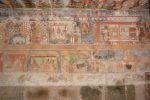
Date: 17th century
Description: Top row: View of the Tyagaraja Temple; On the right the sanctuaries of Tyagaraja and Valmikinatha, on the left the temple tank. Bottom row: The calf is run over by the prince’s chariot. The bystanders are distressed. Bottom row: Manuniti Cholan surrounded by his ministers.
Location: Tamil NaduTemple;Tyagaraja Temple;Tiruvarur
Positioning: Devasiriya mandapa, north wall
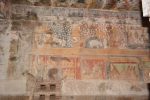
Date: 17th century
Description: Top row; the calf is run over by the prince’s chariot; The cow runs towards the palace and rings the bell. Bottom row: the king and his ministers.
Location: Tamil Nadu Temple;Tyagaraja temple;Tiruvarur
Positioning: Devasiriya mandapa, north wall